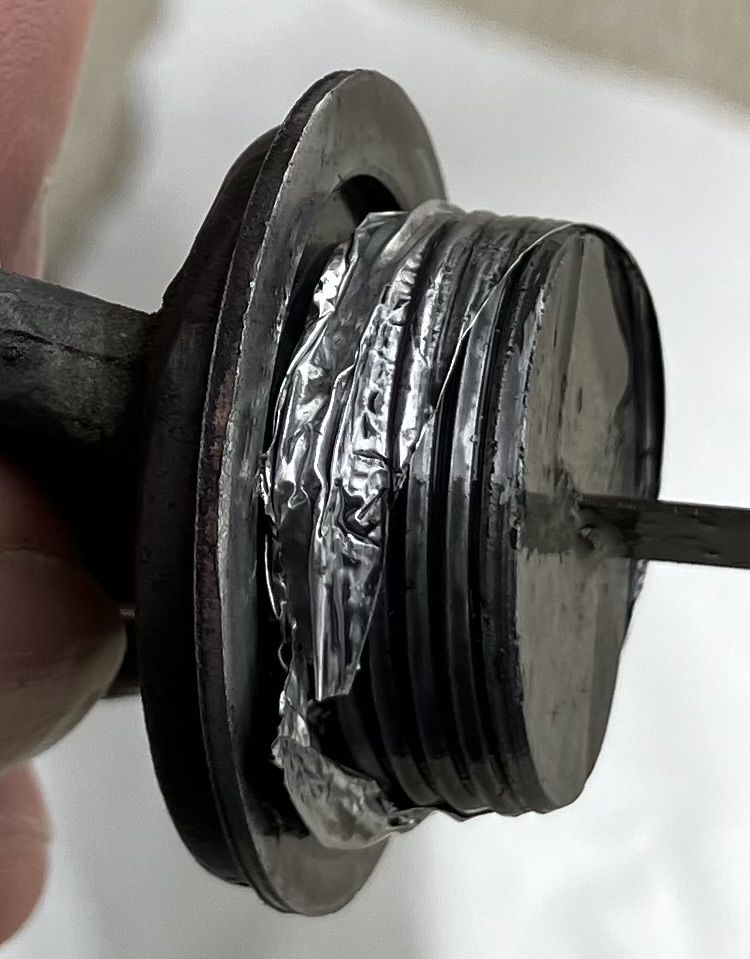And now for something completely different: Ladybugs!

It’s my blog, and I’ll write what I want to! Though this post was certainly inspired by watching a ladybug come out of the pupae stage into the adult stage, getting a few photos, and… hey, did you know what color they are when they come out of the pupae stage? Neither did I!
The Geosafari Ladybug Garden
My daughter likes ladybugs. She really likes ladybugs, and last year, she saved up some money and got something she’s wanted for a while: A ladybug garden! This is a bugtight (if correctly closed…) plastic enclosure that’s designed as a habitat for ladybugs. The company ships you the larvae at the proper time of year, and, if all goes well, you get a bunch of ladybugs out of it!
The top twists off for access (if you don’t get it back correctly, larvae and ladybugs can get out), and there a few plastic magnifiers in the top to inspect your bugs. The top one (the orange one) screws out as well for easier access to one of the spots for the water sponge.

It comes with a reasonable enough little manual, though the “certificate for larvae” is a formality - you just order and pay for them through the website, and can order them in following years with no special procedures - a “Free, plus shipping and handling!” sort of arrangement. If there’s a problem, contact them and they seem to do a good job of making it right.

Inside the booklet, there’s a nice little diagram of the ladybug lifecycle - and while I’ve not see the “eggs” part of it, you should get a good view of the rest of it in this post!

Apologies for some of the photos - taking pictures through a thick plastic enclosure isn’t something I really have the best cameras for. But you should be able to get the idea!
Larvae
The early stage of the ladybugs you get is the larvae stage (unless you get eggs - I understand early on, you can get shipped eggs). These are… weird looking little things. Here, they’re drinking from the water sponge all at once. They’re like long tailed ants, but with stripes - and they’re surprisingly fast, especially if the lid is off to put in some larvae food (little tiny red pellets).

At various points throughout their lifecycle, they will glue themselves, tail-first, to some vertical surface. They shed their outside layers a few times as they grow, leaving plenty of empty skins behind them.

Pupae Balls
Eventually, they stick, tail first, and ball up into the pupae stage. I don’t have any great photos of this stage (mostly because I wasn’t planning to make this into a blog post until I got the photos of the ladybug emerging from this stage), but they’re a fat little ball, stuck to some surface or another with a weird little web of sticky stuff.
Once all the larvae are in this stage, you simply wait for something to happen.

Emerging as Adults
The set of photos that inspired this post happened late at night, shortly before bed. Checking on the garden before bed, one of the pupae was really wiggling around - and that tends to imply something interesting is in the process of happening! So, a bit of camera work later, I got this sequence.
You can see the weird attachment legs against the (fake) tree here - I’m really not sure if they’re the larvae’s legs that get left behind, or something that grows out from the initial attachment point. I don’t think it’s the legs, based on where they are and the size, but… insects are weird, and I don’t know an awful lot about the details. Here, the whole thing was wiggling, and there are what look like ladybug wings at the bottom.

Spotted. Red. Clearly, the shell, right?

Except, as the process continued, these spotted shells started to split apart, and left my wife and I more confused than ever. The whole thing was splitting, and something white-ish was starting to come out. Normal? No idea!

After another minute or two, it was becoming clear that the thing coming out was coming out head first, extending down. And, now far more clear than before, the whole thing is a translucent white except for some black spots on what seems like the head. You can see the legs starting to unfold underneath.

A bit later, something recognizable as a ladybug is certainly coming out - just, white. With what might be the start of spots on it. Apparently ladybugs have to develop their color like a Polaroid picture! If you don’t know what that is, go ask your parents.

Zoom in a bit with a better lens, and you have something that would be entirely at home in a black and white B grade horror movie from the 60s or 70s. Attack of the Giant Ladybug Beetles from Gamma Zeta or something.

Seriously. Weird stuck-to-the-wall adhesive-with-legs, a segmented shell, and a large beetle-like thing coming out, legs waving. All this needs is a theremin.

Once mostly out, it proceeds to twist up towards the wall and use the standard stickyfeet technique to cling to the wall. You can see one of the other pupae at the bottom of the frame - still developing the internal changes required to go from larvae to ladybug!

“General! The first one is free! It’s coming this way!” “Load all main cannons! May God have mercy on us!”

“Sir! It’s preparing to fire it’s bugbutt!”

And, here we go. The black spots are on the thorax, the head is off to the right with two small antennae, and you can see the spots forming on the abdomen.

After wandering around for a minute or two, it proceeded to climb back on the husk it left behind, and presumably do some snacking on whatever of value is left.

This is what’s left over after a ladybug breaks free. If you ever find these in your garden, now you know!

Ladybugs
Give them an hour or two (I don’t know how long it takes exactly, but this one was standard red and black by morning), and you get a normal ladybug. Here, snacking on some of the remaining larvae food. They certainly seem to still enjoy it!

However, once there a few ladybugs, you’re supposed to put some fruit in for them - either cut a raisin in half and soak it, or put a banana slice in. This year, ours preferred the banana slice over the raisins, for some reason. Last year, they were perfectly happy with the half raisins.

Perks of being a small bug: You can really experience the slice of banana, if you want! Climb on it, eat it, feel it against your body…

One of the interesting benefits of a clear container is that you can see the underside far more readily than you can just handling one - they don’t really like being upside down and sitting around for photos, but if they’re wandering the side, you can nail them with a good flash and macro shot easily! So, bug bellies!

They’ll hang around on the fibers that were in the container the larvae shipped in as well - apparently they’re good fun to climb around on, because we regularly have some that just hang out in there - upside down, down under them, or half buried in a tangle of them.

Spots!

Ladybug Lovin’!
When summer turns to “Seriously, it’s been insanely hot, will someone turn down the oven?” outside, a ladybug’s desires turn to other things - and, apparently, we’ve got a pretty even gender mix in our batch, because there’s a lot of “piggyback rides” going on this year in the garden!

We’re going to see if we can convince any to lay eggs in the enclosure this year - no idea if it will work (they can wait several months to lay eggs), but they’re certainly working on it!

And, of the ten ladybugs we have, we’ve seen four couplings. At the same time.

Release
Once all this is done, you release them out into the garden! This was last year’s release - we haven’t let the current set out quite yet. But they enjoy our gardens!

And, of course, get to explore while being released. It’s good fun to help them out and encourage them to go find their way!

My daughter has been finding a lot of ladybugs around this year, and I expect at least some are related to last year’s release!
Final Thoughts
This was originally a “Ok, we’ll do this once…” sort of project - and it’s turned into something that will probably happen every year, at least for a while! It’s exceedingly interesting, a good learning experience for kids, and my wife and I both enjoy watching the development as well!
So, if you have kids, pick one of these up!
Comments
Comments are handled on my Discourse forum - you'll need to create an account there to post comments.If you've found this post useful, insightful, or informative, why not support me on Ko-fi? And if you'd like to be notified of new posts (I post every two weeks), you can follow my blog via email! Of course, if you like RSS, I support that too.






